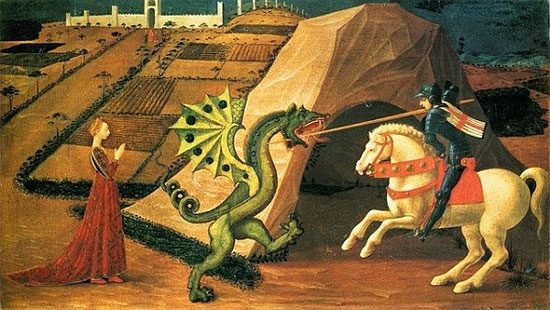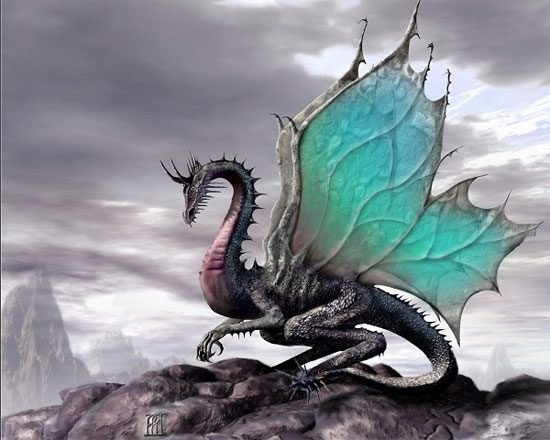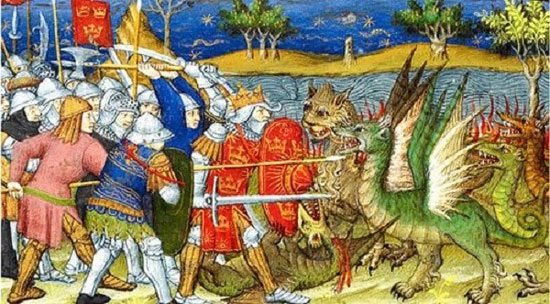Dragons are mythical creatures in legends, often considered products of human imagination. However, numerous mysterious stories and legends have recorded the appearance of these large, flying beings capable of breathing fire.
Found in both Eastern and Western mythology, dragons are known as legendary creatures with extraordinary powers. Most of us believe that these mythical beings do not exist, yet human history has documented their appearances multiple times.

The oldest epic, The Epic of Gilgamesh, written in 2000 BC in Mesopotamia, describes a creature named Humbaba with a unique appearance. It has a lion’s mane, a serpent’s face, horns all over its body, vulture-like claws, cow-like horns on its head, and a mouth capable of spewing both fire and water.
Even in the Bible, this mythical creature is described, with Daniel noted as the first person to kill a “dragon“. After witnessing the Babylonians worship a giant, winged reptile that could breathe fire and fly, Daniel demonstrated that this enormous, bizarre creature only caused chaos and took human lives.
Despite his efforts to prove this, many did not believe him. Therefore, Daniel devised a plan to kill it by feeding it large amounts of fat, hair, and flammable materials before making the creature explode.
A well-known European legend is about St. George, who accidentally came to a strange town threatened by a fearsome dragon. Here, he saved a maiden, protected himself with a cross, and ultimately killed the beast.
The townspeople admired St. George’s bravery and faith, immediately uniting under Christianity. A similar tale involves St. Columba, who in 565 defeated a giant water monster. Interestingly, both were real knights in history.

St. George and the Dragon – Painting by Paolo Uccello, 1470
During the Middle Ages, Viking ships often featured a carved dragon head at the front. They believed it would help camouflage against the dragons of the sea. At that time, most Vikings were either atheists or followed Norse religion, valuing bravery and science, which likely explains their belief in the existence of sea dragons.
Imagination or Real Creature?
Not only do dragons exist in religious texts, but many scientific and historical documents also record encounters with these creatures. In the history of the Macedonian Empire, there is a story of Alexander the Great during his invasion of India, where he recounted to his soldiers a strange tale of a giant lizard living in a cave, known for its ferocity and danger.

In his book recounting his travels in China, Marco Polo tells of a mysterious encounter. During an adventure in the province of Karajan, he came across a giant snake with two short front legs, each with three claws.
It had a wide mouth and sharp teeth capable of swallowing a man, with an extremely fierce disposition… Its appearance was enough to instill fear in any animal. The book also mentions that many local youths would gather in groups to hunt this creature, believing its blood was highly nutritious.

Dragon Illustration by Scientist Aldrovandi
Aldrovandi, regarded as the father of modern natural science, documented many details about the creatures he believed to be dragons. As a scientist, he traveled extensively, collecting data on thousands of species of animals and plants to establish the first natural history museum.
During a field trip in the outskirts of Bologna on May 13, 1572, Aldrovandi observed a creature over 1 meter long that hissed like a snake. According to his description, this creature had a beast-like head, two small front legs, a swollen body covered in many horn-like scales, and a pair of wings on its back.
The peculiar animal was killed by farmers and dismembered in Aldrovandi’s presence. He immediately sketched the creature, believing it could be a young dragon that had not fully developed.

European Dragon Illustration
In the library of King Henry VIII, there are many books and images discussing dragons. Some of these books record: “This special creature is larger than all other snakes or any living being on Earth. It typically resides in caves, has a crest, a narrow mouth, and often exhales hot air. Its strength lies not in its teeth but in its massive tail.
Some dragons carry poison but rarely use it. All dragons are born in Ethiopia and India – places with year-round hot temperatures. From here, they travel all over the world thanks to their wings.” Many contemporaries believed that King Henry had kept a dragon in the basement of his castle.

Dragons Appear in Many Cultures
The famous historian of the 17th century, Christopher Schorerum, recounted an incredible experience in his autobiography: “On a warm night in 1619, I saw a bright mass appear in the sky. At first, I thought it was a meteor, but upon closer inspection, it was a huge creature with a long neck and tail, a head resembling a reptile, and a fierce jaw. As it flew, it seemed to scatter sparks everywhere…”
On April 26, 1890, multiple newspapers in Arizona reported that cowboys had seen a dragon in the sky. Witnesses described its wingspan as several meters, with a body length of 27 meters, and a head resembling that of a lizard with a long, fearsome beak. This description perfectly matched that of the Quetzalcoatlus dinosaur, a fossil discovered in Texas a few years later.

Dr. Donald Stewart, a biologist researching at Morar Lake in Scotland, described a dragon-like creature with a hump on its back, approximately 6 meters long. In August 1969, while fishing at Morar Lake, two men, Duncan McDonnell and Bill Simpson, encountered a monster nearly 8 meters long when it collided with their boat. It had thick, dark brown skin with three black humps on its back, a snake-like head, and quickly disappeared after one man struck it with a paddle while the other fired a shot.

With their prevalence in culture and clear historical records, we can still hope that giant reptiles living in caves, oceans, or remote valleys and forests, referred to as “dragons,” are real. They truly remain a great mystery, waiting for the day we might discover them.
Real Dragon Species and Dragon Fossils
In reality, the Komodo dragon in Indonesia is considered one of the clearest pieces of evidence of the existence of this mythical creature. However, it is not as absurd as human imagination suggests.

In the Middle Ages, the Vikings believed in the existence of a sea dragon capable of attacking fishermen’s boats. In reality, the sea dragon (also known as the leafy sea dragon) is indeed real. It is one of the rarest fish species found on the ocean floor, resembling the dragons of legend. These fascinating creatures are exclusively found along the West and South coasts of Australia.



















































